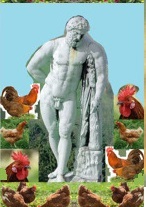[DE]An einem Wochenende im August 2017 feierten wir in Falkenstein, Molfsee und auf der Förde ein großartiges Mega-Fest. Zu diesem Anlass legte die Kieler Cachergemeinde rund um Molfsee viele schöne Caches, die auf der Karte das Torhaus des Molfseer Freilichtmuseums nachbilden. Die Dosen, die bereits archiviert werden mussten, werden nun mit den [GCD17] neo - Dosen ersetzt. Wir wünschen Euch viel Spaß!
[EN] One weekend in August 2017 we celebrated a great mega festival in Falkenstein, Molfsee and on the fjord. For this occasion, the Kieler cache community laid out many beautiful caches around Molfsee, which built on the map the gate house of the open-air museum in Molfsee. The caches, that had to be archived, are now replaced with new ones prefixed [GCD17] neo. We wish you a lot of fun!
Hühnergötter? Was um Himmelswillen sind Hühnergötter? Das mögen sich viele "Zugereiste" fragen, wenn sie das erste Mal in den hohen Norden kommen.

Hühnergötter nennen wir Norddeutschen Steine, meist Feuersteine, die vom Wasser ausgewaschene Löcher haben. Meist handelt es sich um Feuersteinknollen, in denen sich ein Seelilienstängel eingelagert hatte. Die Löcher können nur stecknadelkopfgroß sein, oder aber auch mehrere Zentimeter betragen. In Deutschland kommen Hühnergötter an der Ost- sowie Nordseeküste und in eiszeitlichen Geröllen des Binnenlandes vor und sind bei Strandspaziergängen beliebte Sammelobjekte. Wir haben jedenfalls zu Hause ganze Kartons voll und auch im Garten hängen viele Hühnersteinketten zur Deko. Im übrigen Deutschland sind Hühnergötter eher selten zu finden oder als Begriff unbekannt.
Die Bezeichnung Hühnergott entstammt der Vorstellung, dass Hühnergötter am Hühnerstall aufgehängt, das Hausgeflügel gegen böse Geister schützen sollen. In der slawischen Sage geht es um die Abwehr des schädlichen Einflusses eines weiblichen Hausgeistes, der sogenannten Kikimora.
Die Kikimora ist eine alte slawische Gottheit. Ihr wird unter anderem nachgesagt, dass sie Fäden spinnt, poltert, demjenigen, der sie sieht, Unglück bringt – und das Hausgeflügel stiehlt oder es am Eierlegen hindert. Um den bösen Einfluss abzuwehren, muss der abgeschlagene Hals eines Kruges oder aber ein Stein mit einem natürlichen Loch bei den Ställen aufgehängt werden.
Quelle: Wikipedia

English Version
Chicken gods? What on earth are chicken gods? Many "SH-newbies" may ask themselves this question, when they come into the high North for the first time.
Chicken gods we call stones, mostly fire stones, which have holes washed out by the water. Mostly they are flint nodules, in which a stark of a sea lily had been stored. The holes can only be as hugh as a pinhead, or they can be several centimetrers. In Germany, you can find chicken gods at the Baltic and North Sea coasts and in the ice age gravel in the interior of Schleswig-Holstein, and are popular collector's items for beach walks. Anyway, we have a lot of boxes at home and also in the garden we have a lot of chicken stone chains for decoration. In the rest of Germany, chicken gods are rather rarely to be found or unknown as a term.
The term chicken god comes from the idea that chicken gods are hung up in the hen house to protect the domestic poultry against evil spirits. The Slavic myth is about the defence of the harmful influence of a female domestic spirit, just the so-called Kikimora.
The Kikimora is an ancient Slavic goddess. Among other things, she is said to be spinning threads, rumbling, someone, who sees her, brings misfortune - and steals domestic poultry or prevents it from laying eggs. In order to ward off the evil influence, the a beaten neck of a jug or a stone with a natural hole must be trapped in the stables.
Source: Wikipedia

Wer möchte und Spaß daran hat, kann sich nach dem Fund dieses Banner in sein Profil einbinden:
[EN:] If you like you may add this banner to your profile:

Dazu einfach folgenden HTML-Text in euer Profil einfügen:
[EN:] To do so just add the following HTML code to your profile
<a href="https://www.geocaching.com/bookmarks/view.aspx?guid=8f93395c-0be3-436f-bf79-0dfe860bbbc6">
<img src="https://s3.amazonaws.com/gs-geo-images/9c1405d3-cd4b-4c9c-bb58-69b4ee9084aa_l.jpg" width="275" border="1"
title="Das lächelnde Mega-Torhaus"></a> |